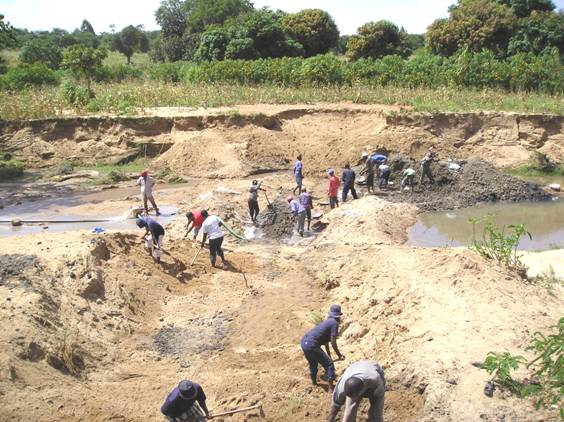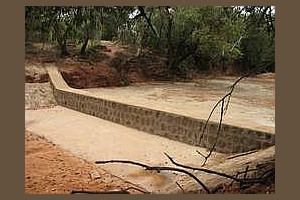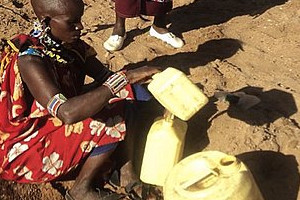Difference between revisions of "地下集水系统"
Weichen Chen (talk | contribs) (Created page with "__NOTOC__ <small-title /> 80px Image:SubsurfaceDamSite.JPG|thumb|right|200px|2007年,人们在肯尼亚基图伊含沙的...") |
Weichen Chen (talk | contribs) (→Construction, operations and maintenance) |
||
| Line 41: | Line 41: | ||
更多关于治理干旱的信息,请查看: [[Resilient WASH systems in drought-prone areas |易干旱地区具有适应性的WASH系统]]. | 更多关于治理干旱的信息,请查看: [[Resilient WASH systems in drought-prone areas |易干旱地区具有适应性的WASH系统]]. | ||
| − | === | + | ===修建、运作和维护=== |
| − | ''' | + | '''关于水泥的建议''':建筑和隔板(例如水箱、水坝、水道和水井)出现裂缝的常见原因是在混合 |
| + | 和使用水泥时出错。首先,很重要的一点是使用的成分一定要纯:干净的水、沙子和岩石,这 | ||
| + | 些成分必须充分混合。第二,混合时使用的水尽量少:混凝土或水泥成形即可,宁可干点,也 | ||
| + | 不要成为液体。第三,在固化过程中混凝土或水泥需要有一定的水分,至少维持一周。同时, | ||
| + | 引水建筑物应该用塑料、大树叶或其他材料覆盖以保持水分。 | ||
| + | |||
| − | ''' | + | '''具体建议''': |
| − | [[Image:SubsurfaceDam.jpg|thumb|right|200px| | + | [[Image:SubsurfaceDam.jpg|thumb|right|200px|地下水坝的示意图。图片来源: WHO.]] |
| − | + | 水坝可使用有防水膜(如塑胶片、粘土层或加固土)的水泥、砌砖、砌块墙和装有石头的石笼修建。 | |
| − | * | + | * 地下水坝的顶部至少低于地表1米,因此陆地才不会积水。 |
| − | * | + | * 地下水坝应该有翼墙,就像[[sand dam|沙坝]],可在翼墙上堆积岩石防止侵蚀。 |
| − | * | + | * 水可由水坝上游不远处的水井抽取,或者由排水系统从水坝的上游底端收集水然后引至下游水井或重力自流管系统中。 |
| − | * | + | * 如果可以,可安装冲水阀来促进地下水坝的清洁。 |
| − | * | + | * 可使用塑料干毯防止水坝漏水。建议在沟渠下游用泥巴和水将坡度抚平以防止尖锐的石头和根茎刺穿塑料干毯。 |
| − | ==== | + | ====维护==== |
| − | * | + | * 应定期清洗水井或重力自流管。 |
| − | * | + | * 每次严重的洪水之后,水坝的任何损坏都需要修复,而且如有必要,也需要用大石头保护水坝。 |
| − | * | + | * 对于大规模的修复,例如水坝漏水或是遭到洪水破坏,则需要许多人力和重型机器,也需要咨询专业技术人员。 |
| − | * | + | * 在旱季时地下水的盐度增加,可在水坝的底部安放一个补给管道,以便每年稀释盐分。 |
| − | + | 通常由使用者、负责人或看守人来进行维护。大规模的修复则需要技术工人(可以是当地工匠)。有时候也需要大量没有技术的人员(例如在修复渗漏的地下水坝时)。使用者应进行维护(有无酬劳皆可)或者专门雇人来维护。 | |
| − | + | 使用者们可能需要在当地成立一个委员会来处理以下问题,例如控制或监督用水,防止水污染、实施运作和维护活动、运作和维护活动的财务以及监测剩余水量(可安装地下水位计或螺旋钻孔方便看守人估计剩余水量并决定是否需要定量供应)。合理的管理可防止出现社会矛盾。可以指派在附近居住或耕作的人来负责大坝的运作和维护。如果使用者在大坝附近或者在大坝取水,该负责人也可以负责水的分配及监控。所有的使用者应熟知并尊重负责人的职权。 | |
===Costs=== | ===Costs=== | ||
Revision as of 09:18, 19 October 2015

在天然形成冲积层的地方使用地下水坝可在水坝的上游进行蓄水,从而抬高地下水位并防止水分蒸发流失。这样的构造能减少或阻止浅层地下水的流动。通过挖沟至基岩或河底不渗透的土层,地下水坝建在山谷中季节性干旱且含沙的河床上。位于沟渠中的水坝可以由墙或隔板组成,并由挖掘物覆盖直到完全掩盖。填充材料必须适当压实。有两种类型的地下水坝:一种在此介绍,另一种是沙坝。地下水坝更容易修建。因为是在现有的河床中修建,因此发生洪水之后,由于水位变高水量将增加。
适宜条件
- 与沙坝选址要求相似。
- 地下水坝应该修建在泥沙含量足以蓄水的地方。
- 半干旱地区的季节性河流,含有可渗透沉淀物以及浅防渗层(最深3-4米)。
- 通常斜度在1%到2%之间的河谷蓄水量最大。
- 地下水从面积大的流域流向狭窄河道时最为理想。
| 优势 | 劣势 |
|---|---|
| - 地下水坝不容易损坏,也不容易出现裂口 - 水蒸发流失量远远少于干旱热带地区自由水面每年流失两米的水量 |
- 很难发现渗漏情况 - 水可能通过防渗层的缝隙流失了(可以在断裂区挖井并利用水坝作为人工补给建筑物) |
应对环境变化的适应性
干旱
干旱的后果: 可能会干涸
潜在的原因: 降雨减少导致含水层补给变少;人口及用水需求增加;含水层的面积—例如有限的泥沙含量;太多泥沙淤积在水坝后面;水井深度不够;水坝选址不当导致漏水。
增加WASH系统的适应性: 选址正确,施工适当;分阶段修建沙坝以减少泥沙;在上游流域运用保护土壤和水的技术;将抽水井/管道挖得更深一些。
更多关于治理干旱的信息,请查看: 易干旱地区具有适应性的WASH系统.
修建、运作和维护
关于水泥的建议:建筑和隔板(例如水箱、水坝、水道和水井)出现裂缝的常见原因是在混合 和使用水泥时出错。首先,很重要的一点是使用的成分一定要纯:干净的水、沙子和岩石,这 些成分必须充分混合。第二,混合时使用的水尽量少:混凝土或水泥成形即可,宁可干点,也 不要成为液体。第三,在固化过程中混凝土或水泥需要有一定的水分,至少维持一周。同时, 引水建筑物应该用塑料、大树叶或其他材料覆盖以保持水分。
具体建议:
水坝可使用有防水膜(如塑胶片、粘土层或加固土)的水泥、砌砖、砌块墙和装有石头的石笼修建。
- 地下水坝的顶部至少低于地表1米,因此陆地才不会积水。
- 地下水坝应该有翼墙,就像沙坝,可在翼墙上堆积岩石防止侵蚀。
- 水可由水坝上游不远处的水井抽取,或者由排水系统从水坝的上游底端收集水然后引至下游水井或重力自流管系统中。
- 如果可以,可安装冲水阀来促进地下水坝的清洁。
- 可使用塑料干毯防止水坝漏水。建议在沟渠下游用泥巴和水将坡度抚平以防止尖锐的石头和根茎刺穿塑料干毯。
维护
- 应定期清洗水井或重力自流管。
- 每次严重的洪水之后,水坝的任何损坏都需要修复,而且如有必要,也需要用大石头保护水坝。
- 对于大规模的修复,例如水坝漏水或是遭到洪水破坏,则需要许多人力和重型机器,也需要咨询专业技术人员。
- 在旱季时地下水的盐度增加,可在水坝的底部安放一个补给管道,以便每年稀释盐分。
通常由使用者、负责人或看守人来进行维护。大规模的修复则需要技术工人(可以是当地工匠)。有时候也需要大量没有技术的人员(例如在修复渗漏的地下水坝时)。使用者应进行维护(有无酬劳皆可)或者专门雇人来维护。
使用者们可能需要在当地成立一个委员会来处理以下问题,例如控制或监督用水,防止水污染、实施运作和维护活动、运作和维护活动的财务以及监测剩余水量(可安装地下水位计或螺旋钻孔方便看守人估计剩余水量并决定是否需要定量供应)。合理的管理可防止出现社会矛盾。可以指派在附近居住或耕作的人来负责大坝的运作和维护。如果使用者在大坝附近或者在大坝取水,该负责人也可以负责水的分配及监控。所有的使用者应熟知并尊重负责人的职权。
Costs
Initial costs: A 3500 m3 dam costs US$2.40/m3 in Kenya and US$3.90/m3 in Tanzania.
General costs:
- Materials costs and construction: US$1,400
- Feasibility study: US$200
- Technical support: US$275
- Operation and maintenance: low
Field experiences
- A subsurface reservoir in Pernambuco, Brazil has an average depth of 4m, is 50m wide, and 500m long, storing about 4,000m3 of water.
 Dawa Eresa Subsurface and Sand Dam project |
 Feasibility Study for Rainwater Harvesting |
Manuals, videos, and links
- Technology Notes: Subsurface Dams - Section 11. Water Aid.
- Subsurface dams for water storage in dry riverbeds. Waterforaridland.com.
Acknowledgements
- Brikke, François, and Bredero, Maarten. Linking technology choice with operation and maintenance in the context of community water supply and sanitation: A reference document for planners and project staff. World Health Organization and IRC Water and Sanitation Centre. Geneva, Switzerland 2003.
- Smart Water Harvesting Solutions: Examples of innovative, low cost technologies for rain, fog, and runoff water and groundwater. (or alternative link) Netherlands Water Partnership, Aqua for All, Agromisa, et al. 2007.
- CARE Nederland, Desk Study: Resilient WASH systems in drought-prone areas. October 2010.


